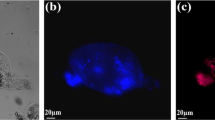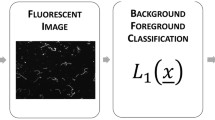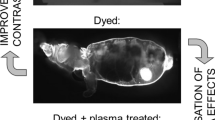Abstract
Giardia is a pathogenic protozoan that has caused giardiasis outbreaks worldwide, and this water-borne disease may occur due to faults in water supply and treatment systems. To support surveillance and control programs, the monitoring of this parasite is essential in water samples. Although Giardia cyst detection is usually based on standard light microscopy, the resulting low contrasted cysts together with a wide array of particles of comparable size to the target protozoan demands a high level of observer skill and experience, as well as a long time to process the individual samples. The visualization of this protozoan can be significantly improved by using staining procedures, e.g., Lugol’s iodine in brightfield or fluorescence-based methods such as fluorescence-isothiocyanate (FITC) and 4′,6-diamidino-2-phenylindole (DAPI). However, the significant costs make fluorescence microscopy difficult to be performed in less-developed countries. Accordingly, the present study evaluated the effectiveness of inexpensive darkfield (DF) setups to acquire higher contrasted images of unstained cyst samples as a direct and rapid method for monitoring protozoa. Two low-cost custom-made DF illumination modes, transmitted and reflected, were evaluated on a standard light microscope. Examination of purified Giardia cyst suspensions with both DF setups revealed a direct correlation between morphological appearance and uptake of DAPI. Images captured under transmitted illumination showed higher contrast and sharpness when compared to the reflected images. DF microscopy might provide a simple, direct, and inexpensive method for observing Giardia cysts, which shows basic aspects of their intracellular structure, although the applicability of the method to raw water concentrates remains to be demonstrated.







Similar content being viewed by others
References
Baldursson, S., & Karanis, P. (2011). Waterborne transmission of protozoan parasites: review of worldwide outbreaks–an update 2004–2010. Water Research, 45, 6603–6614.
Bruun, J. M., Carstensen, J. M., Vejzagić, N., Christensen, S., Roepstorff, A., & Kapel, C. M. O. (2014). OvaSpec—a vision-based instrument for assessing concentration and developmental stage of Trichuris suis parasite egg suspensions. Computers in Biology and Medicine, 53, 94–104.
Burgemeister, S., Nattkemper, T. W., Noll, T., Hoffrogge, R., & Flaschel, E. (2010). CellViCAM—cell viability classification for animal cell cultures using dark field micrographs. Journal of Biotechnology, 149, 310–316.
Dalynn Biologicals (2005). Lugol’s iodine stain. Catalogue n SL95. http://www.dalynn.com/dyn/ck_assets/files/tech/SL95.pdf. Accessed 2 April 2018.
Efstratiou, A., Ongerth, J., & Karanis, P. (2017). Evolution of monitoring for Giardia and Cryptosporidium in water. Water Research, 123, 96–112.
Gage, S. (1920). Modern dark-field microscopy and the history of its development. Transactions of the American Microscopical Society, 39, 95–141.
Jamjoom, G. A. (1983). Dark-field microscopy for detection of malaria in unstained blood films. Journal of Clinical Microbiology, 17(5), 717–721.
Karanis, P., Kourenti, C., & Smith, H. (2007). Waterborne transmission of protozoan parasites: a worldwide review of outbreaks and lessons learnt. Journal of Water and Health, 5(1), 1–38.
Kawano, Y., Higgins, C., Yamamoto, Y., Nyhus, J., Bernard, A., Dong, H. W., Karten, H. J., & Schilling, T. (2013). Darkfield adapter for whole slide imaging: adapting a darkfield internal reflection illumination system to extend WSI applications. PLoS One, 8(3), e58344.
Landry, S., McGhee, P., Girardin, R., & Keeler, W. (2004). Monitoring live cell viability: comparative study of fluorescence, oblique incidence reflection and phase contrast microscopy imaging techniques. Optics Express, 12(23), 5754–5759.
Lane, S., & Lloyd, D. (2002). Current trends in research into the waterborne parasite Giardia. Critical Reviews in Microbiology, 28(2), 123–147.
Maciel, P. M. F., & Sabogal-Paz, L. P. (2016). Removal of Giardia spp. and Cryptosporidium spp. from water supply with high turbidity: analytical challenges and perspectives. Journal of Water and Health, 14(3), 369–378.
Murphy, D. B. (2001). Fundamentals of light microscopy and electronic imaging (pp. 112–116). New York: Wiley-Liss.
Pluta, M. (1989). Advanced light microscopy, volume 2: specialized methods (pp. 102–113). Amsterdam: Elsevier Science Publishers.
Preza, C., King, S. V., Dragomir, N. M., & Cogswell, C. J. (2011). Phase imaging microscopy: beyond darkfield, phase and differential interference contrast microscopy. In D. A. Boas, C. Pitris, & N. Ramanujam (Eds.), Handbook of Biomedical Optics (pp. 483–517). New York: Taylor and Francis Books.
Rodgers, M. R., Flanigan, D. J., & Jakubowaski, W. (1995). Identification of algae which interfere with the detection of Giardia cysts and Cryptosporidium oocysts and a method for alleviating this interference. Applied and Environmental Microbiology, 61(10), 3759–3763.
Sauch, J. F. (1985). Use of immunofluorescence and phase-contrast microscopy for detection and identification of Giardia cysts in water samples. Applied and Environmental Microbiology, 50(6), 1434–1438.
Tibayrenc, P., Ghommidh, C., & Preziosi-Belloy, L. (2011). Determination of yeast viability during a stress-model alcoholic fermentation using reagent-free microscopy image analysis. Biotechnol Prog, 27(2), 539–546.
United States Environmental Protection Agency – USEPA. (2012). Method 1623.1 Cryptosporidium and Giardia in water by filtration/IMS/FA. EPA 816 – R-12-001. Office of Water (MS-140). Washington, D.C.: Environmental Protection Agency.
Wayne, R. (2014). Light and video microscopy: 2nd Edition (p. 366). San Diego: Academic Press.
Wei, N., Flaschel, E., Friehs, K., & Nattkemper, T. W. (2008). A machine vision system for automated non-invasive assessment of cell viability via dark field microscopy, wavelet feature selection and classification. BMC Bioinformatics, 9, 449.
Wilson, B., & Vigil, G. (2013). Automated bacterial identification by angle resolved dark-field imaging. Biomedical Optics Express, 4(9), 1692–1701.
Funding
This work was supported by the São Paulo Research Foundation (FAPESP-Brazil) under Grant Processes 2014/12712-8 and 2012/50522-0 and by the Coordination for the Improvement of Higher Education Personnel (CAPES-Brazil) for the Master’s scholarship awarded to Bárbara Luíza Souza Freitas.
Author information
Authors and Affiliations
Corresponding author
Rights and permissions
About this article
Cite this article
Belini, V.L., Freitas, B.L.S., Sabogal-Paz, L.P. et al. Label-Free Darkfield-Based Technique to Assist in the Detection of Giardia Cysts. Water Air Soil Pollut 229, 195 (2018). https://doi.org/10.1007/s11270-018-3834-x
Received:
Accepted:
Published:
DOI: https://doi.org/10.1007/s11270-018-3834-x




